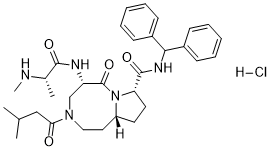| Cas No.: | 1071992-57-8 |
| Chemical Name: | Xevinapant hydrochloride |
| Synonyms: | Benzeneacetamide, 4-chloro-N-[1-[[(cyanoamino)[(2-methyl-3-pyridinyl)imino]methyl]amino]-2,2-dimethylpropyl]-;AT-406;AT-406 HCl;(5S,8S,10aR)-N-(Diphenylmethyl)decahydro-5-[[(2S)-2-(methylamino)-1-oxopropyl]amino]-3-(3-methyl-1-oxobutyl)-6-oxo-pyrrolo[1,2-a][1,5]diazocine-8-carboxamide hydrochloride (1:1);AT406;SM 406;AT 406;(5S,8S,10aR)-N-benzhydryl-5-((S)-2-(methylamino)propanamido)-3-(3-methylbutanoyl)-6-oxodecahydropyrrolo[1,2-a][1,5]diazocine-8-carboxamide;Debio 1143;N65WC8PXDD;(5S,8S,10aR)-N-(Diphenylmethyl)-5-[(N-methyl-L-alanyl)amino]-3-(3-methylbutanoyl)-6-oxodecahydropyrrolo[1,2-a][1,5]diazocine-8-carboxamide;GTPL7729;Xevinapant;Xevinapant hydrochloride |
| SMILES: | O=C1[C@H](CN(C(CC(C)C)=O)CC[C@H]2CC[C@@H](C(NC(C3C=CC=CC=3)C3C=CC=CC=3)=O)N21)NC([C@H](C)NC)=O |
| Formula: | C32H43N5O4 |
| M.Wt: | 597.310 |
| Purity: | >98% |
| Sotrage: | 2 years -20°C Powder, 2 weeks 4°C in DMSO, 6 months -80°C in DMSO |
| Description: | Xevinapant (AT-406) hydrochloride is a potent and orally bioavailable Smac mimetic and an antagonist of the inhibitor of apoptosis proteins (IAPs). Xevinapant hydrochloride binds to XIAP, cIAP1, and cIAP2 proteins with Kis of 66.4, 1.9, and 5.1 nM, respectively. Xevinapant hydrochloride effectively antagonizes XIAP BIR3 protein in a cell-free functional assay, induces rapid degradation of cellular cIAP1 protein, and inhibits cancer cell growth in various human cancer cell lines. Xevinapant hydrochloride is highly effective in induction of apoptosis in xenograft tumors[1][2]. |
| Target: | cIAP1:1.9 nM (Ki) cIAP2:5.1 nM (Ki) XIAP:66.4 nM (Ki) |
| In Vivo: | Xevinapant (AT-406) hydrochloride is very effective in inhibition of tumor growth in the MDA-MB-231 xenograft model, and has minimal toxicity to animals[1]. Xevinapant hydrochloride evaluated for its pharmacokinetic (PK) properties in mice, rats, non-human primates and dogs[1]. Animal Model: SCID mice bearing MDA-MB-231 xenograft tumors[1] Dosage: 30 and 100 mg/kg Administration: p.o.; 5 days a week for 2 weeks Result: Strongly inhibits tumor growth at 30 and 100 mg/kg and completely inhibits tumor growth during the treatment with 100 mg/kg. |
| In Vitro: | Xevinapant (AT-406) hydrochloride potently inhibits cell growth in the MDA-MB-231 breast and SK-OV-3 ovarian cancer cell lines with IC50=144 nM and 142 nM, respectively.Xevinapant (0-3 μM; 0-48 horus) hydrochloride effectively induces cell death in a time- and dose-dependent manner[1]. |
| References: | [1]. Cai Q, Sun H, Peng Y, et al. A potent and orally active antagonist (SM-406/AT-406) of multiple inhibitor of apoptosis proteins (IAPs) in clinical development for cancer treatment. J Med Chem. 2011;54(8):2714-2726. [2]. Brunckhorst MK, et al. AT-406, an orally active antagonist of multiple inhibitor of apoptosis proteins, inhibits progression of human ovarian cancer. Cancer Biol Ther. 2012;13(9):804-811. |

 To enhance service speed and avoid tariff delays, we've opened a US warehouse. All US orders ship directly from our US facility.
To enhance service speed and avoid tariff delays, we've opened a US warehouse. All US orders ship directly from our US facility.




















